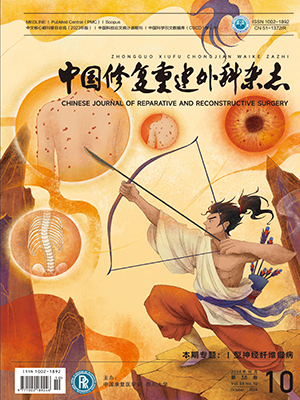Objective To assess an effect of 5-fluorouracil (5-FU) applied topically on the tendon adhesion and the healing process after the flexor tendon repair in Leghorn chickens. Methods Thirtytwo white Leghorn chickens, aged 4 months and weighing 1.5-1.7 kg, were randomly divided into 2 groups: Group A andGroup B, with 16 chickens in each group. The flexor digitorum profundus tendons of the 2nd, 3rd and 4th toes were transected and repaired. The repair site in Group A was given 5-FU in a concentration of 25 mg/ml with a soaked sponge that wascut into pieces 7 mm×20 mm×1 mm in size, and the synovial sheath of the repair site was wrapped with the 5-FU-soaked sponge for 1 min for 4 times. The repair site in Group B was served as a control, with no 5-FU but with the sterile normal saline. At 3 and 6 weeks postoperatively, the repaired tendons and the tendon adhesion formation were examined macroscopically and histologically,and the repaired tendons were tested biomechanically. The tissue blocks from the tendon repair site were examined under the transmission electron microscope. Results At 3 and 6 weeks postoperatively, the macroscopic and histological observation showed that the peritendinous adhesions in Group A were looser when compared with those in Group B. The length of the tendon gliding and the extent of yieldance to exercise were found to be 4.85±1.31 mm, 0.67±0.42 mm and 5.74±1.61 mm, 1.55±0.35 mm respectively at 3 and 6 weeks after operation in Group A,but 2.99±0.51mm,0.24±0.14 mm and 3.65±0.54 mm, 1.22±0.16 mm in Group B.Group A was significantly greater in the abovementioned parameters than Group B (P<0.05).At 3 weeks after operation, the ultimate breaking strength was 20.28±4.92 N in Group A and 21.29±4.88 N in Group B, with no statistically significant difference found between the two groups (P>0.05). At 6 weeks, the ultimate breaking strength was 47.12±6.76 N in Group A but 39.31±7.20 N in Group B, with a significant difference between the two groups (P<0.05). Conclusion 5-fuorouracil, when appliedtopically, can reduce the tendon adhesion, with no inhibition of the intrinsic healing mechanism. It is an ideal treatment strategy to prevent peritendinous adhesion.
Citation: GUO Mingke,ZHANG Jingqi,TIAN Dehu,et al.. AN EFFECT OF 5-FLUOROURACIL ON TENDON ADHESION FORMATION AFTER FLEXOR TENDON REPAIR IN CHICKENS. Chinese Journal of Reparative and Reconstructive Surgery, 2007, 21(8): 842-846. doi: Copy




